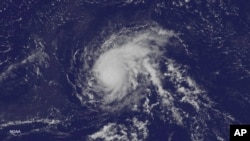A new report finds most natural disasters in 2014 were climate-related.
The 2015 World Disasters Report, issued Thursday by the International Federation of Red Cross and Red Crescent Societies, say climate change will lead to an increase in the frequency and severity of future hazards.
Compared to previous years, 2014 was in many ways a statistically better year in regard to global disasters. The latest report cites 317 disasters worldwide, the lowest number of the decade or 17 percent below the average.
Lead editor of the report, Mo Hamza, says nearly 107 million people were affected by these disasters. He acknowledges this is a relative increase on the previous year.
“But, this number is still well below the highest number of disasters in the past decade, which occurred in 2005 when a total of 810 disasters were reported," he said. "In 2014, disasters caused 8,186 deaths worldwide. Nevertheless, the mortality level was almost 90 percent lower than the decade's average.”
Asia is the most disaster-prone region in the world. The report finds 48 percent of all disasters occurred in Asia in 2014. More than 85 percent of those killed and affected globally also were in Asia.
The report ranks China as the world’s most disaster-affected country in the world, noting 731 people were killed in an earthquake in August 2014. It says drought, storms and flooding affected more than 58 million people in China.
Hamza tells VOA 87 percent of global disasters were climate-related, continuing a 20-year trend of climate-related disasters.
“There is no doubt that extreme events impacted by climate change in terms of frequency and magnitude, that is no longer in doubt," he said. "But what matters as much is how vulnerable populations are in the hot spots, that is in low-lying deltas and in coastal zones, for example.”
The report shows floods and landslides accounted for nearly half of all natural disasters in 2014 and were responsible for 63 percent of disaster-affected deaths. It cites floods in India, Pakistan, and the Balkans among the most severe.
It calls the impact of drought, which affected 39 percent of all people last year, a disaster often overlooked by the more visually dramatic floods. Yet, it says this forgotten, silent disaster severely affects the economic well-being of millions of people, especially in the Sahel region of Africa.
The report estimates economic losses in 2014 at $99.2 billion, well below the annual average of $147 billion seen during the past 10 years.
